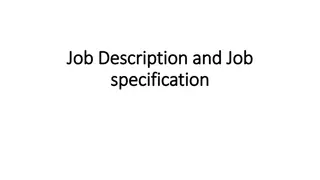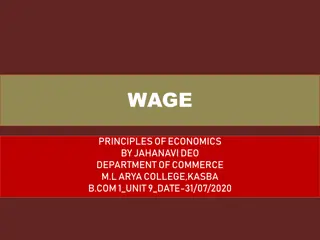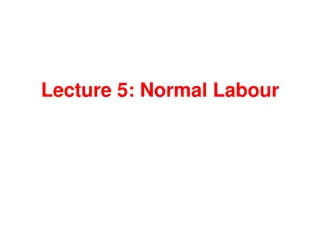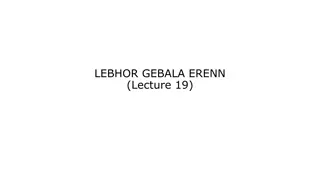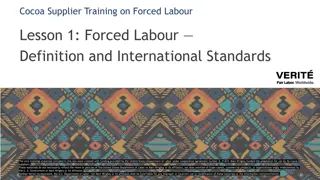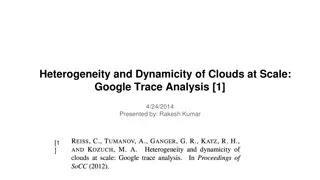Analyzing Wages and Job Churn Data in Irish Labour Market
This study delves into the changes in wages in Ireland post the Great Recession, the flexibility in the Irish labour market regarding wages, and how firms varied in the pay adjustments they implemented. Advantages and disadvantages of utilizing job churn data for analysis are discussed, along with an examination of earnings dynamics and job stayers' trends over several years.
Download Presentation

Please find below an Image/Link to download the presentation.
The content on the website is provided AS IS for your information and personal use only. It may not be sold, licensed, or shared on other websites without obtaining consent from the author.If you encounter any issues during the download, it is possible that the publisher has removed the file from their server.
You are allowed to download the files provided on this website for personal or commercial use, subject to the condition that they are used lawfully. All files are the property of their respective owners.
The content on the website is provided AS IS for your information and personal use only. It may not be sold, licensed, or shared on other websites without obtaining consent from the author.
E N D
Presentation Transcript
Using Job Churn Administrative Data for Labour Market Analysis Aed n Doris, Donal O Neill & Olive Sweetman Maynooth University 4thAdministrative Data Seminar, Dublin Castle, April 20, 2015
Our Questions 1. How have wages in Ireland changed as a result of the Great Recession/Crisis? 2. What degree of flexibility in wages is there in the Irish labour market? 3. To what extent did firms differ in the pay cuts/rises they gave?
Advantages & Disadvantages of Job Churn data Free from reporting errors usually a major concern in measuring wage changes Broad income measure gross taxable pay , includes bonuses and benefit-in- kind But net of pension contributions No information on hours worked so cannot consider hourly wages No information on education levels, firm tenure or occupation, so potential for detailed analysis based on individual characteristics is limited No labour market status information, so we cannot separately identify the unemployed, the non-participants and the emigrants Very limited information on firms but potential for merger with other datasets to overcome this? Firm identifiers allow identification of stayers those in the same job in successive periods Matching of employers and employees allows analysis of within-firm changes huge potential for firm and industry level analysis
Earnings Dynamics, Job Stayers Year Median Change Mean Change Proportion Freezes Proportion Cuts Proportion Increases 2005/06 0.060 0.070 0.025 0.172 0.804 2006/07 0.061 0.070 0.025 0.176 0.799 2007/08 2008/09 -0.006 -0.020 0.033 0.045 0.049 0.028 0.229 0.527 0.742 0.440 2009/10 -0.011 -0.013 0.044 0.552 0.403 2010/11 0.006 0.013 0.068 0.393 0.539 2011/12 0.008 0.016 0.103 0.342 0.555 2012/13 0.008 0.020 0.100 0.343 0.557
Earnings Dynamics, Job Stayers Year Median Change Mean Change Proportion Freezes Proportion Cuts Proportion Increases 2005/06 0.060 0.070 0.025 0.172 0.804 2006/07 0.061 0.070 0.025 0.176 0.799 2007/08 2008/09 -0.006 -0.020 0.033 0.045 0.049 0.028 0.229 0.527 0.742 0.440 2009/10 -0.011 -0.013 0.044 0.552 0.403 2010/11 0.006 0.013 0.068 0.393 0.539 2011/12 0.008 0.016 0.103 0.342 0.555 2012/13 0.008 0.020 0.100 0.343 0.557
Earnings Dynamics, Job Stayers Year Median Change Mean Change Proportion Freezes Proportion Cuts Proportion Increases 2005/06 0.060 0.070 0.025 0.172 0.804 2006/07 0.061 0.070 0.025 0.176 0.799 2007/08 2008/09 -0.006 -0.020 0.033 0.045 0.049 0.028 0.229 0.527 0.742 0.440 2009/10 -0.011 -0.013 0.044 0.552 0.403 2010/11 0.006 0.013 0.068 0.393 0.539 2011/12 0.008 0.016 0.103 0.342 0.555 2012/13 0.008 0.020 0.100 0.343 0.557
Earnings Dynamics, Job Stayers Year Median Change Mean Change Proportion Freezes Proportion Cuts Proportion Increases 2005/06 0.060 0.070 0.025 0.172 0.804 2006/07 0.061 0.070 0.025 0.176 0.799 2007/08 2008/09 -0.006 -0.020 0.033 0.045 0.049 0.028 0.229 0.527 0.742 0.440 2009/10 -0.011 -0.013 0.044 0.552 0.403 2010/11 0.006 0.013 0.068 0.393 0.539 2011/12 0.008 0.016 0.103 0.342 0.555 2012/13 0.008 0.020 0.100 0.343 0.557
Earnings Dynamics, Job Stayers Year Median Change Mean Change Proportion Freezes Proportion Cuts Proportion Increases 2005/06 0.060 0.070 0.025 0.172 0.804 2006/07 0.061 0.070 0.025 0.176 0.799 2007/08 2008/09 -0.006 -0.020 0.033 0.045 0.049 0.028 0.229 0.527 0.742 0.440 2009/10 -0.011 -0.013 0.044 0.552 0.403 2010/11 0.006 0.013 0.068 0.393 0.539 2011/12 0.008 0.016 0.103 0.342 0.555 2012/13 0.008 0.020 0.100 0.343 0.557
Earnings Dynamics, Job Stayers Year Median Change Mean Change Proportion Freezes Proportion Cuts Proportion Increases 2005/06 0.060 0.070 0.025 0.172 0.804 2006/07 0.061 0.070 0.025 0.176 0.799 2007/08 2008/09 -0.006 -0.020 0.033 0.045 0.049 0.028 0.229 0.527 0.742 0.440 2009/10 -0.011 -0.013 0.044 0.552 0.403 2010/11 0.006 0.013 0.068 0.393 0.539 2011/12 0.008 0.016 0.103 0.342 0.555 2012/13 0.008 0.020 0.100 0.343 0.557
Earnings Dynamics, Job Stayers Year Median Change Mean Change Proportion Freezes Proportion Cuts Proportion Increases 2005/06 0.060 0.070 0.025 0.172 0.804 2006/07 0.061 0.070 0.025 0.176 0.799 2007/08 2008/09 -0.006 -0.020 0.033 0.045 0.049 0.028 0.229 0.527 0.742 0.440 2009/10 -0.011 -0.013 0.044 0.552 0.403 2010/11 0.006 0.013 0.068 0.393 0.539 2011/12 0.008 0.016 0.103 0.342 0.555 2012/13 0.008 0.020 0.100 0.343 0.557
Annual Earnings Changes, Job Stayers, 2005/09 2005 to 2006, All Workers 2006 to 2007, All Workers 10 10 8 8 6 6 Percent Percent 4 4 2 2 0 0 -.5 -.4 -.3 -.2 -.1 0 .1 .2 .3 .4 .5 -.5 -.4 -.3 -.2 -.1 0 .1 .2 .3 .4 .5 Proportionate Change in Annual Pay Proportionate Change in Annual Pay 2007 to 2008, All Workers 2008 to 2009, All Workers 10 10 8 8 6 6 Percent Percent 4 4 2 2 0 0 -.5 -.4 -.3 -.2 -.1 0 .1 .2 .3 .4 .5 -.5 -.4 -.3 -.2 -.1 0 .1 .2 .3 .4 .5 Proportionate Change in Annual Pay Proportionate Change in Annual Pay
Annual Earnings Changes, Job Stayers, 2009/13 2009 to 2010, All Workers 2010 to 2011, All Workers 10 10 8 8 6 6 Percent Percent 4 4 2 2 0 0 -.5 -.4 -.3 -.2 -.1 0 .1 .2 .3 .4 .5 -.5 -.4 -.3 -.2 -.1 0 .1 .2 .3 .4 .5 Proportionate Change in Annual Pay Proportionate Change in Annual Pay 2011 to 2012, All Workers 2012 to 2013, All Workers 10 10 8 8 Percent Percent 6 6 4 4 2 2 0 0 -.5 -.4 -.3 -.2 -.1 0 .1 .2 .3 .4 .5 -.5 -.4 -.3 -.2 -.1 0 .1 .2 .3 .4 .5 Proportionate Change in Annual Pay Proportionate Change in Annual Pay
Median Cumulative Pay Changes: By Industrial Sector All Sectors Agriculture & Mining Manufacturing Utilities Construction Wholesale/Retail Transport/Storage Accommodation/Food Information/Communication Finance/Insurance Real Estate Professional/Scientific Administrative/Support Public Admin & Education Health Arts/Recreation Other Services -.1 0 .1 .2 .3 Median Cumulative Earnings Change 2005-2008 2008-2013
Measuring Wage Rigidity Downward wage rigidity can be the result of contracts being negotiated in advance, or firms reluctance to cut wages due to negative morale effects We want to measure the proportion of workers who do not receive pay cuts, but who would in the absence of rigidity International Wage Flexibility Project (Dickens et al., 2007) covered 16 countries, including Ireland. Proposed measure of rigidity: F + C F where C is the proportion of workers affected by pay cuts, F is the proportion of workers affected by pay freezes Assumes that all wage changes that are prevented by wage rigidity are piled up into wage freezes Downward rigidity in Ireland reported as being the lowest of all countries included in the study (4% vs. mean of 28%) But note that ECHP data used for Ireland suffers from measurement error
The Time Pattern of Wage Rigidity Year Wage Rigidity 2005/06 0.181 2006/07 0.173 2007/08 0.164 2008/09 0.101 2009/10 0.127 2010/11 0.213 2011/12 2012/13 0.275 0.274
The Time Pattern of Wage Rigidity Year Wage Rigidity 2005/06 0.181 2006/07 0.173 2007/08 0.164 2008/09 0.101 2009/10 0.127 2010/11 0.213 2011/12 2012/13 0.275 0.274
The Time Pattern of Wage Rigidity Year Wage Rigidity 2005/06 0.181 2006/07 0.173 2007/08 0.164 2008/09 0.101 2009/10 0.127 2010/11 0.213 2011/12 2012/13 0.275 0.274
The Time Pattern of Wage Rigidity Year Wage Rigidity 2005/06 0.181 2006/07 0.173 2007/08 0.164 2008/09 0.101 2009/10 0.127 2010/11 0.213 2011/12 2012/13 0.275 0.274
Variation Between Firms in Wage Changes As well as having data on individuals, we have firm identifiers, so we can characterize within-firm wage distributions fully We can examine whether firms adopted different approaches to wage changes Did some firms give only pay rises, while others gave only pay cuts? If so, we should find substantial between-firm variation in firms mean pay changes To examine this, we calculate the variance of individual workers wage changes and decompose this variance into two parts: 1. The part due to within-firm variance in wage changes 2. The part due to between-firm variance in mean wage changes
Decomposition of Variance of Individual Wage Changes, Job Stayers Year Total Variance of Log Pay Change 0.0187 Proportion Between Firms 0.13 Proportion Within Firms 0.87 2005/06 0.0196 0.12 0.88 2006/07 0.0207 0.0239 0.15 0.25 0.85 0.75 2007/08 2008/09 0.0207 0.18 0.82 2009/10 0.0211 0.15 0.85 2010/11 0.0204 0.10 0.90 2011/12 0.0185 0.10 0.90 2012/13
Decomposition of Variance of Individual Wage Changes, Job Stayers Year Total Variance of Log Pay Change 0.0187 Proportion Between Firms 0.13 Proportion Within Firms 0.87 2005/06 0.0196 0.12 0.88 2006/07 0.0207 0.0239 0.15 0.25 0.85 0.75 2007/08 2008/09 0.0207 0.18 0.82 2009/10 0.0211 0.15 0.85 2010/11 0.0204 0.10 0.90 2011/12 0.0185 0.10 0.90 2012/13
Decomposition of Variance of Individual Wage Changes, Job Stayers Year Total Variance of Log Pay Change 0.0187 Proportion Between Firms 0.13 Proportion Within Firms 0.87 2005/06 0.0196 0.12 0.88 2006/07 0.0207 0.0239 0.15 0.25 0.85 0.75 2007/08 2008/09 0.0207 0.18 0.82 2009/10 0.0211 0.15 0.85 2010/11 0.0204 0.10 0.90 2011/12 0.0185 0.10 0.90 2012/13
Decomposition of Variance of Individual Wage Changes, Job Stayers Year Total Variance of Log Pay Change 0.0187 Proportion Between Firms 0.13 Proportion Within Firms 0.87 2005/06 0.0196 0.12 0.88 2006/07 0.0207 0.0239 0.15 0.25 0.85 0.75 2007/08 2008/09 0.0207 0.18 0.82 2009/10 0.0211 0.15 0.85 2010/11 0.0204 0.10 0.90 2011/12 0.0185 0.10 0.90 2012/13
Distribution of Pay Cut Proportions Across Firms, Job Stayers aged 25-60, Various Years Distribution of Firm Cuts Proportion Across Firms, 2005 to 2006 Distribution of Firm Cuts Proportion Across Firms, 2007 to 2008 14 14 12 12 10 10 Percent Percent 8 8 6 6 4 4 2 2 0 0 0 .2 .4 .6 .8 1 0 .2 .4 .6 .8 1 Proportion of Firm's Workers with Pay Cuts Proportion of Firm's Workers with Pay Cuts Distribution of Firm Cuts Proportion Across Firms, 2012 to 2013 Distribution of Firm Cuts Proportion Across Firms, 2008 to 2009 14 14 12 12 10 10 Percent Percent 8 8 6 6 4 4 2 2 0 0 0 .2 .4 .6 .8 1 0 .2 .4 .6 .8 1 Proportion of Firm's Workers with Pay Cuts Proportion of Firm's Workers with Pay Cuts
Cross-Firm Variation in Wage Changes: Additional Results We can examine the characteristics both within and between firms that are associated with bigger wage increases (or smaller wage cuts) Between firm analysis: use the Between estimator regresses firm average characteristics on firm average pay changes Results: firms with younger workers, with lower-paid workers, with more female workers and with fewer Irish workers had bigger wage increases or smaller cuts in all years Within firm analysis: use the Fixed Effects estimator regresses within-firm deviations from the firm mean characteristic on the deviation from the firm mean wage change of individual pay changes Results: younger, male, lower-paid workers, had bigger pay increases/smaller cuts. Pre-crisis, non-Irish workers had bigger pay rises, but this switched during the crisis so that in 2010-2013, Irish workers had bigger pay rises/smaller cuts
Conclusions I Matched employer-employee administrative data allows us to examine the issue of wage flexibility in far greater detail than has been done previously Pre-crisis: significant degree of downward wage flexibility in annual wages confirmed Crisis Onset: Aggregate figures suggest a limited wage response to the crisis. However, medians mask considerable heterogeneity Proportion of workers receiving pay cuts trebled overall; increased by factor of 2.75 in private sector Proportion of freezes stayed low. Measured wage rigidity fell substantially Many workers continued to receive pay rises as others received cuts However, the firm the worker was in was not the primary driver of the size of their wage change: within-firm variation in wage changes accounted for the bulk of variation in individual pay changes
Conclusions II Post-Crisis Recessionary-Recovery Period: Proportion of workers receiving pay cuts declined relative to crisis peak, but still high by international standards Spike at zero increased significantly perhaps due to resistance to pay cuts in successive years As a result, measured wage rigidity rose significantly. Irish level now around average across countries found in Dickens et al. (2007). Must be taken in context of remarkable extent of earnings cuts As expected, the industrial sectors most involved in the crisis suffered most in terms of pay, with the notable exception of Finance









